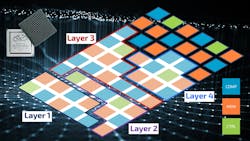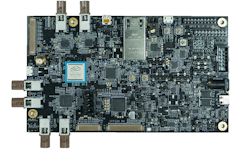Machine-Learning Chip Takes on Rugged Apps—from Cars to Wearables
It’s possible to incorporate machine-learning (ML) and artificial-intelligence (AI) methodologies at the edge, where many compact, embedded IoT devices live using standard processors and SoCs. However, this limits the functionality that can be provided due to computational limitations. Utilizing specialized AI accelerators is a requirement when tackling problems such as image recognition with streaming video
Hailo Technologies, based in Tel Aviv, has created the Hailo-8 (Fig. 1), a compact chip designed for rugged environments including automotive applications. It offers significantly higher performance while using less power than many GPGPU-based solutions. Consuming less than 1.7 W, it can deliver a 682-frame/s processing speed for the ResNet-50 benchmark with 224- by 224-pixel resolution, 8-bit precision, and a batch size of 1. Small batch sizes are important on the edge.
1. Hailo Technologies’ Hailo-8 is a compact chip designed for rugged environments, including automotive applications.
The Hailo-8 distributes multiple layers of an ML model across its collection of compute, memory, and control blocks (Fig. 2). An interconnect provides FPGA-like configurability, allowing the Hailo-8 to process one or more models at the same time.
2. The Hailo-8 can distribute multiple layers of an ML model across its collection of compute (COMP), memory (MEM), and control (CTRL) blocks.
In addition, Hailo crafted the Hailo-8 development board (Fig. 3), a Developer Suite, and software development kit (SDK). The SDK supports ONNX and TensorFlow. It handles automatic numerical conversion and emulation with profiling support.
3. The Hailo-8 development board, Developer Suite, and SDK are available to select customers.
The Hailo-8 can act as a host driven by sensors with a MIPI or parallel interface. The system is able to use SDIO or Ethernet to communication with other systems. Furthermore, an application processor can take advantage of the Hailo-8 with these interfaces as well as a PCI Express (PCIe) interface.
Sample chips are available now with production in 2020. The chip will be ASIL-B certifiable.
About the Author
William G. Wong
Senior Content Director - Electronic Design and Microwaves & RF
I am Editor of Electronic Design focusing on embedded, software, and systems. As Senior Content Director, I also manage Microwaves & RF and I work with a great team of editors to provide engineers, programmers, developers and technical managers with interesting and useful articles and videos on a regular basis. Check out our free newsletters to see the latest content.
You can send press releases for new products for possible coverage on the website. I am also interested in receiving contributed articles for publishing on our website. Use our template and send to me along with a signed release form.
Check out my blog, AltEmbedded on Electronic Design, as well as his latest articles on this site that are listed below.
You can visit my social media via these links:
- AltEmbedded on Electronic Design
- Bill Wong on Facebook
- @AltEmbedded on Twitter
- Bill Wong on LinkedIn
I earned a Bachelor of Electrical Engineering at the Georgia Institute of Technology and a Masters in Computer Science from Rutgers University. I still do a bit of programming using everything from C and C++ to Rust and Ada/SPARK. I do a bit of PHP programming for Drupal websites. I have posted a few Drupal modules.
I still get a hand on software and electronic hardware. Some of this can be found on our Kit Close-Up video series. You can also see me on many of our TechXchange Talk videos. I am interested in a range of projects from robotics to artificial intelligence.




